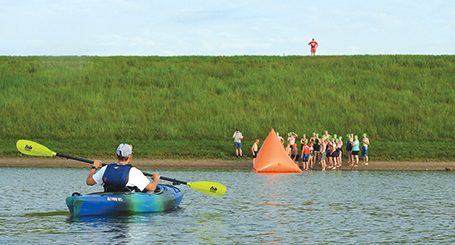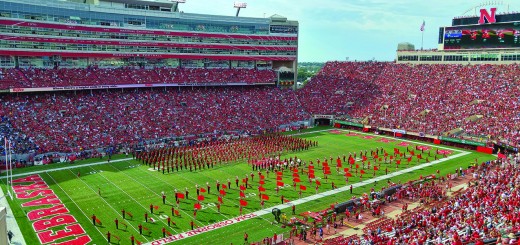The Cornhusker Tradition

by Ken Hambleton
When a subject dominates passion, joy and, yes, depression, it usually withers and fades away.
Nothing is more discussed, more covered in depth by more media and remains the beating heart of Nebraska than Nebraska football.
Since 1891, through the national championship years in the 1990s, to the current struggles, Husker football was, is and will be the symbol of so many people in the state.
The Cornhusker tradition, usually on fall Saturdays, is all-encompassing. From the Pride of Nebraska marching band to the red and white football uniforms worn by so many in-state kids and a large number of players from all around the country, Nebraska football is the engine that drives the state.
Memorial Stadium was built the same time the State Capitol was built. But you can’t fit 90,000 screaming fans into the Capitol. It would seem weird to see so many people wearing red shirts, red pants, red hats attending a session of the legislature.
The Huskers
From the beginning, when trainloads of Husker fans, actually fans of the Old Gold Knights at the time, traveled to Omaha in the 1890s to later treks to Iowa, Minnesota, the Midwest and the 1941 Rose Bowl, the Crimson and Cream—Red and White to the modern fans—have been a focal point in Nebraska.
Every home game since 1962 has been sold out. Every road game is buttressed with plenty of red and white and that includes a game in Tokyo in 1962 and a game in Dublin, Ireland to open the 2022 season.
Lincoln thrives on Nebraska football. Only the cities of Omaha and Lincoln have a larger gathering of people than Memorial Stadium on home Saturdays. Nothing fills the restaurants, bars and hotels and streets like our football games.
The Huskers—named Cornhuskers in 1904 after brief stints as Bugeaters, Old Gold Knights and Antelopes—captured the hearts and minds of football fans everywhere but, as the fight song says, no place like Nebraska.
Traditions are strong: the unity walk of fans and players to the stadium some two hours before kickoff, the Pride of Nebraska Marching Band parading 10th Street an hour before the game, releasing red balloons for the first touchdown, huge crowds in dozens of bars and restaurants, the human traffic jam in the Haymarket Railyard, and just about every nook and cranny that can hold a radio or a TV on a Saturday morning, afternoon or night.
Note: if you wan to be an insider—the red shirts, red clothing, red everything picked up steam in the 1950s. The Black Shirts tradition started in 1963 when assistant coach Mike Corgan went to a local sporting goods store to get practice jerseys and black was on sale. Since then, the Nebraska defense has awarded black shirts to the starting players and fans picked up on the Black Shirt tradition when NU defenses were largely responsible for national championships in 1970, 1971, 1994, 1995 and 1997.
The Huskers reached three other national championship games during that span as well. The heroes are part of the football lexicon when talking about the Huskers.
Heisman Trophy winners Johnny Rodgers, Mike Rozier and Eric Crouch, Outland Trophy winner Dave Rimington, All-American Rich Glover, Jerry Tagge, Jeff Kinney, Tommie Fraszier, Ndamukong Suh, Roger Craig, Irving Fryar, Grant Wistrom, Jason Peter, Mike Brown, Broderick Thomas, Dominic Raiola and dozens of others are Husker football legends.
Trev Alberts, an All-American defensive end, is the current Nebraska athletic director. Mickey Joseph is the Cornhuskers’ interim coach.
Fans still speak with reverence of former Husker defensive coordinator Charlie McBride and offensive line coach Milt Tenopir.
There is awe of the great Tom Novak, whose No. 60 is the only number retired by Nebraska and still known as the toughest Husker ever. Guy Chamberlin, who starred in the 1910s, is a member of the National Football Hall of Fame alongside former Nebraska guard Bob Brown. George Flippin, the first black player west of the Mississippi in the early 1900s, Forrest Behm, who was All-American and a later WWII war hero, Bobby Reynolds, Will Shields and Neil Smith, who became some of the all-time greats for the Kansas City Chiefs, Ahman Green and Tom Rathman, went on to become top pros as well.
That’s why long, long into every night during the season, even with less fortunate outcomes in recent years, thousands devour every word written and spoken through dozens of news outlets throughout every season.
Despite some lean years in recent games, Nebraska is still the seventh winningest football program in college football history.
Bob Devaney came to Nebraska from Wyoming in 1962 and brought the program to national prominence. Tom Osborne, a graduate assistant coach under Devaney, took over the offense in 1969, then became head coach in 1973. The Huskers took five national titles, were ranked in the Top Ten almost every year during their run. Frank Solich, an assistant to Osborne, took over in 1998, and still Nebraska played in national championship games.
Since then, the ups and downs have pulled at the heartstrings of Nebraska football fans, but the hopes spring eternal.














Recent Comments